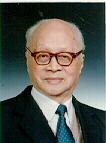Wang Ganchang
Wang Ganchang (Chinese: 王淦昌), born in 1907, was an outstanding nuclear physical scientist and one of China's initial researchers in nuclear physics, cosmic rays and particle physics.
Wang was from Changshu City, Jiangsu province, and graduated from the physics department of Tsinghua University in 1929. He later furthered his studies in Germany in 1930 and got his Ph.D. degree in 1933. Wang returned to China in April 1934 and served as a professor at Shandong University and later Zhejiang University. He joined the Communist Party of China in 1979.
From the spring of 1969, he was vice director of the Ninth Research Institute. He was also director of the Institute of Atomic Energy, vice chairman of the China Association for Science and Technology, and the first chairman of the China Nuclear Society.
In 1941, due to a proposal by Wang, the international science community proved the existence of neutrinos for the first time. Then, in 1959, Wang and his colleagues expanded scientific understanding of the basic particle family with the discovery of the charged antiparticle sigma negative hyperon. He also proposed using high-power laser beam targeting to achieve inertial confinement fusion in 1964.
Because of his outstanding contributions, Wang was awarded the National Natural Science Award.
Wang passed away in Beijing on Dec. 10, 1998, at the age of 91.
